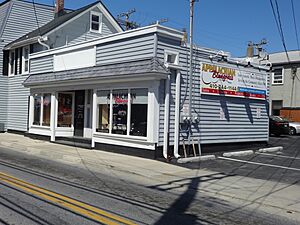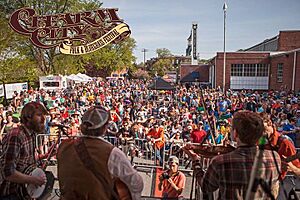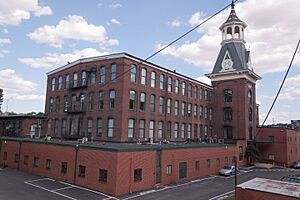History of the Appalachian people in Baltimore facts for kids
The city of Baltimore, Maryland is home to many people with Appalachian roots. Appalachia is a large region in the eastern United States, known for its mountains and unique culture. In Baltimore, the Appalachian community has historically lived in neighborhoods like Hampden, Pigtown, Remington, and Highlandtown. Some also settled in nearby areas like Dundalk and Essex.
Appalachian culture has greatly influenced Baltimore. This includes their way of speaking, folk traditions, and especially their music. People from Appalachia can be of any race or religion. In Baltimore, most are white or African-American. Some are also Native American or from other backgrounds. White Appalachian people often have ancestors from England, Ireland, Scotland, or Wales.
From the 1920s to the 1960s, many people moved from Appalachia to cities like Baltimore. This was called the Hillbilly Highway for white Southerners. At the same time, many African-Americans moved from the Deep South in what was known as the Great Migration. Native Americans, like the Lumbee and Cherokee, also moved from the Southeast. These migrations deeply shaped Baltimore's culture.
Contents
Appalachian History in Baltimore

In the early 1900s, many young people from Appalachian farms in West Virginia moved to Baltimore. They often followed the Baltimore and Ohio Railroad. Many settled in the Hampden neighborhood. This was because there were many jobs in the mills there. Hampden was built for workers at mills along the Jones Falls river. Most Appalachian people in Hampden came from Eastern Kentucky, West Virginia, and Western Pennsylvania. This made Hampden a well-known working-class neighborhood.
During the Great Depression, thousands of white people from the Appalachian Mountains moved to Baltimore. They also moved to other industrial cities like Detroit and Chicago. This movement of white Appalachian and Southern people happened at the same time as the Great Migration of African Americans from Appalachia and the South. About 11 million Southerners moved north during these times. About two-thirds were white, and one-third were black.
Appalachian people who moved to Baltimore often faced poverty and unemployment. Many industries were changing, and the coal industry was declining. Baltimore's factories filled with Appalachian workers between 1910 and 1960. This was especially true during and after World War II. White working-class families from Kentucky, Ohio, Virginia, and West Virginia created Appalachian communities in Baltimore. Many Black Appalachian and Southern people settled in West Baltimore. They formed communities nicknamed "Little Virginia" or "Little North Carolina."
Armistead Gardens in East Baltimore was built as public housing for white workers during World War II. Most of these workers came from Appalachian states like West Virginia, Kentucky, and Tennessee. They came to Baltimore to work at places like the Glenn L. Martin Company.
During and after World War II, many Southern and Appalachian workers also settled in Sparrows Point. This was an industrial area near Baltimore. They came to work for the Bethlehem Steel plant. Many of these workers were from rural areas and mining towns in West Virginia and Central Pennsylvania. Their descendants still live in areas like Dundalk, Essex, and Armistead Gardens.
In 1984, about 1,100 Appalachian families lived in the Remington neighborhood. Many came from coal towns in Western Pennsylvania and West Virginia. They moved to Baltimore in the 1950s and 1960s for better jobs. By the 1980s, many factories had closed, leading to high unemployment. Even so, few wanted to move back to Appalachia, where conditions were even worse. Many Appalachian children in Remington did not finish high school at that time.
Baltimore was also a major place for Appalachian African-Americans. Many came from Alabama, Georgia, South Carolina, and North Carolina.
Appalachian Culture in Baltimore

Baltimore has a long and important history of bluegrass music. The Baltimore–Washington region has a lively bluegrass music community. This music scene started in the 1930s. Appalachian migrants brought their musical traditions with them. After World War II, Baltimore was even known as the capital of bluegrass music. One of the first famous bluegrass groups in Baltimore was the Stoney Mountain Boys. They were the first bluegrass band to play at Carnegie Hall.
Since 2013, the annual Charm City Bluegrass Festival has celebrated Appalachian music in Baltimore. In 2015, a book called Bluegrass in Baltimore was published. It tells the detailed history of Baltimore's bluegrass music scene.
One of the most famous bluegrass musicians from Baltimore was Hazel Dickens. She was born in West Virginia in 1925. She moved to Baltimore in the 1950s, following her siblings. They left the coal mines for better factory jobs in Baltimore. Her song "Mama's Hand" describes saying goodbye to her mother before leaving for Baltimore. Dickens became a very important woman in bluegrass music. She always supported women and working-class people through her songs. Her lyrics often spoke about labor unions and feminist ideas.
Religious Life
Christian Faiths
Most Southern and Appalachian migrants during the Hillbilly Highway and Great Migration were Protestant. This included both white and black people. This wave of Protestant migrants changed the religious makeup of cities like Baltimore. Before, many working-class people in the Northeast were from Catholic countries in Europe. This "Southernizing" of the American working-class led to a big increase in both white and black Protestant groups in the Northeast.
Jewish Communities
The building of the Baltimore & Ohio railroad through the Appalachian Mountains helped connect Baltimore's Jewish community to new markets. This allowed Jewish people from Baltimore to start businesses and communities throughout Appalachia. Deborah Weiner, a historian at the Jewish Museum of Maryland, wrote a book called Coalfield Jews: An Appalachian History. It tells the story of Jews and Judaism in Appalachia.
Weiner's book shows how Appalachia's coal boom from the 1880s to the 1920s connected with the arrival of Eastern European Jewish immigrants to the United States. She notes that Appalachian Jews sometimes found it hard to fully practice their Jewish heritage in rural areas. Many would leave the mountains to visit relatives in Baltimore or New York. Historically, Jewish communities in Appalachia kept strong ties to Baltimore's Jewish community. For example, in the 1920s, the Hebrew Ladies Aid Society of Welch, West Virginia, regularly donated to Baltimore's matzo fund.
There has long been a strong connection between Jewish people in Appalachian Western Maryland and those in Baltimore. The design of B'er Chayim Temple in Cumberland is based on the older Eden Street Synagogue in Baltimore. Many historical items from B'er Chayim are now on display at the Jewish Museum of Maryland.
Baltimore's Jewish community also helped fund the building of the B’nai Shalom Congregation in Bristol. This is located in the Appalachian part of Western Virginia.
Fitting In and Facing Challenges
White Appalachian people in Baltimore have faced challenges. They sometimes experienced discrimination because of their social class and where they came from. However, they also had some advantages because they were white. White Appalachian people and Southern African Americans (including African-Appalachians) moved to Baltimore in large numbers between the 1920s and 1960s. This led to comparisons between these two groups of new arrivals.
In 1961, a group called the Baltimore section of the National Council of Jewish Women published a report. It was called "The Unaccepted Baltimoreans." This report studied white rural Southern migrants in Baltimore. It said that these migrants were becoming a burden on the city's economy. It also said that there was a need to help Appalachian migrants fit in better. The report suggested they should be encouraged to value education more. The author, Ferne K. Kolodner, was a civil rights activist who wanted to help with urban poverty. She visited many Appalachian homes and interviewed community leaders. She believed Appalachian people had a "limited cultural background" and formed "cultural islands" that were different from middle-class life.
Some poor white Appalachian residents of Pigtown have reported being treated unfairly by the police because of their social class. These Appalachian people came from West Virginia and Western Maryland after World War II. Some say that while poor black people in Pigtown face more discrimination due to both racism and classism, poor whites also experience targeting and harassment from the police.
Famous Appalachian-Americans from Baltimore
- Tori Amos, a well-known singer-songwriter and pianist.
- Tony Campbell, an educator and politician. He ran for the U.S. Senate in 2018.
- Moses H. Cone, a textile business owner and supporter of conservation.
- Cone sisters, Claribel and Etta Cone, who collected a famous collection of modern French art.
- Hazel Dickens, a bluegrass singer and songwriter. Her music often spoke about workers' rights and women's issues.
- Shan Goshorn, an Eastern Band Cherokee artist. Her art focuses on human rights, especially for Native Americans.
- Thomas McElhiney, a diplomat who worked for the United Nations.
- Chet Pancake, a filmmaker, musician, and activist. He works against mountaintop removal mining.




